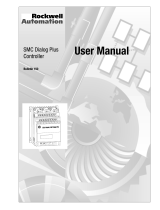
Object name Class Instance Attribute
Restart delay 100 127 100
Motor temperature check 100 128 100
Local/remote 100 129 100
Comms in remote 100 130 100
Input A function 100 131 100
Input A name 100 132 100
Input A trip 100 133 100
Input A trip delay 100 134 100
Input A initial delay 100 135 100
Remote reset logic 100 136 100
Relay A function 100 137 100
Relay A on delay 100 138 100
Relay A o delay 100 139 100
Relay B function 100 140 100
Relay B on delay 100 141 100
Relay B o delay 100 142 100
Relay C function 100 143 100
Relay C on delay 100 144 100
Relay C o delay 100 145 100
Low current ag 100 146 100
High current ag 100 147 100
Motor temperature ag 100 148 100
Analog output A 100 149 100
Analog A scale 100 150 100
Analog A maximum adjustment 100 151 100
Analog A minimum adjustment 100 152 100
Auto-start type 100 153 100
Auto-start time 100 154 100
Auto-stop type 100 155 100
Auto-stop time 100 156 100
Auto-reset action 100 157 100
Maximum resets 100 158 100
Reset delay groups A&B 100 159 100
Reset delay group C 100 160 100
Motor FLC-2 100 161 100
Locked rotor time-2 100 162 100
Start mode-2 100 163 100
Current limit-2 100 164 100
Initial current-2 100 165 100
Start ramp-2 100 166 100
Kickstart level-2 100 167 100
Kickstart time-2 100 168 100
Excess start time-2 100 169 100
Stop mode-2 100 170 100
Stop time-2 100 171 100
Adaptive control gain-2 100 172 100
Adaptive start prole-2 100 173 100
Adaptive stop prole-2 100 174 100
Brake torque-2 100 175 100
Brake time-2 100 176 100
Language 100 177 100
User screen - top left 100 178 100
User screen - top right 100 179 100
Object name Class Instance Attribute
User screen - bottom left 100 180 100
User screen - bottom right 100 181 100
Graph timebase 100 182 100
Graph maximum adjustment 100 183 100
Graph minimum adjustment 100 184 100
Mains reference voltage 100 185 100
Access code 100 186 100
Adjustment lock 100 187 100
Emergency run 100 188 100
Current calibration 100 189 100
Main contactor time 100 190 100
Bypass contactor time 100 191 100
Motor connection 100 192 100
Jog torque 100 193 100
Motor overload 100 194 100
Current imbalance 100 195 100
Undercurrent 100 196 100
Instaneaneous overcurrent 100 197 100
Frequency 100 198 100
Heat sink overtemperature 100 199 100
Table 7.9 Class 100 Objects
7.3.2.2 Class 101 Objects (Read/Write)
Object name Class Instance Attribute
Excess start time 101 100 100
Input A trip 101 101 100
Motor thermistor 101 102 100
Starter communication 101 103 100
Network communication 101 104 100
Battery/clock 101 105 100
Low control volts 101 106 100
Comms timeout 101 107 100
Tracking gain 101 108 100
Tracking gain-2 101 109 100
Frequency detect 101 110 100
Bypass protection 101 111 100
Pedestal detect 101 112 100
Table 7.10 Class 101 Objects
7.3.2.3 Class 103 Objects (Read-only)
Object name Class Instance Attribute
Binary protocol version 103 100 100
Product type code 103 101 100
Minor software version 103 102 100
Major software version 103 103 100
Soft starter model 103 104 100
Parameter changed 103 105 100
Num parameter 103 106 100
Parameter value 103 107 100
Packet Structures Operating Guide
MG17M102 Danfoss A/S © 08/2016 All rights reserved. 17
7 7





















